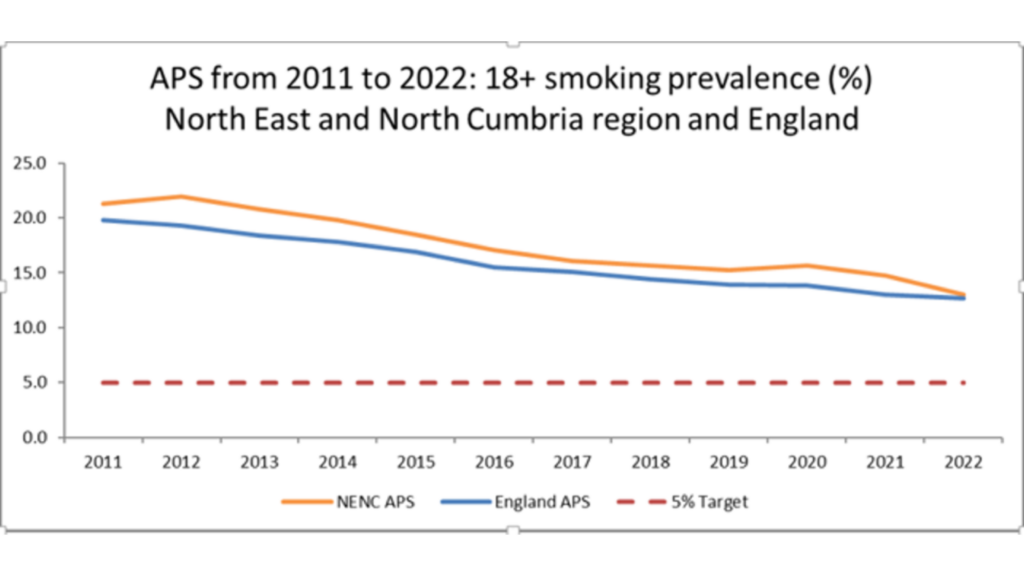North East smoking rates fall to new low
Fresh has welcomed new figures out today showing a further fall in adult smoking in the North East.
Figures published by the Office for National Statistics show adult smoking rates in the North East have fallen from 14.8% in 2021 to 13.1% in 2022.
The data also shows that smoking rates among people in routine and manual occupations is now less than the national average in the North East – 21.6% compared to 22.5% in England nationally. This is a significant achievement in narrowing the gap.
The figures come as Fresh re-launches its Smoking Survivors campaign encouraging thousands more smokers in the region to quit. The campaign features the powerful stories of local cancer survivors Cathy Hunt and Sue Mountain.
The Official Government estimates1 for the rate of smoking and vaping were published this morning. They show:
Overall rate of smoking in adults in England in 2022 was 12.7%. This is down from 13.0% in 2021 but is nowhere near fast enough to achieve the Government’s ambition of 5% or less by 2030.
- Rate of vaping among those 16+ in Great Britain was 8.7%. This is an increase on rates reported in 2021
- Highest levels of vaping are among those aged 16-24 and the highest levels of smoking are among those aged 25-34
Ailsa Rutter OBE, Director of Fresh and Balance, said: “We welcome another fall in smoking here in the North East down to the lowest rates on record. Smoking has more than halved since 2005 when 29% of adults smoked.
“It is credit to partners in our region’s local authorities and the NHS that reducing smoking has been made a top priority. Year round campaigns to raise motivation to quit and ensure smokers have access to support are lifesaving. We are proud of the collaboration over many years on a comprehensive approach to reducing smoking and our clear vision that smoking needs to become a thing of the past, once and for all.
“It is especially encouraging for the North East to see that smoking rates among routine and manual occupations – historically much higher – are now below rates in England for the first time ever. It’s especially positive given the huge pressures facing people in our local communities due to the pandemic and the cost of living crisis.
But she said: “Smoking is still our number one killer and rates are much higher in key groups like people with serious mental illness. Smoking is the key cause of cancer and preventable ill health and cost the region nearly £1 billion a year. Rates of lung cancer are still rising among women. And overall, smoking rates are not falling fast enough. We need more action and more investment at national level through a properly funded new national tobacco control plan, if we are going to reach the government’s own target of reducing adult smoking to 5% by 2030.”
She added: “We also welcome the rise in vaping among adult smokers and ex-smokers. As well as being less risky, vaping is a successful aid to quitting smoking and is now the most popular choice for people stopping smoking. It is vital we don’t scare smokers off a much less risky alternative.
“However, we also recognize the need for urgent measures to restrict youth vaping such as removing child-friendly branding, putting products out of sight and out of reach in shops and raising the price of pocket money priced disposable vapes most popular with children. The Government should act on these now”.
Amanda Healy, Durham County Council’s Director of Public Health and Chair of the Association of Directors of Public Health North East Forum, said: “Most people who smoke start as children and may make several quit attempts. The North East has made a region wide joint commitment to reducing smoking – our aim is to make a real difference to the health and wellbeing of residents across the North East.
“But our region still has some of the highest smoking rates and levels of smoking-related illness in England. Working together we can reduce these but we also need this concerted action at national level.”
ASH Chief Executive Deborah Arnott commenting on slow progress on smoking said: “Today’s figures are a wake-up call. Smoking rates are falling, but not nearly fast enough to deliver on the Government’s ambition of 5% or less by 2030. Financial stress and poor mental health are on the rise, which we know makes it harder for smokers to quit. Initiatives like “Swap to Stop” are helpful but they’re nowhere near enough.
The Government must step up its support to smokers, for example by reinvesting in the vital campaigns to motivate smokers to quit and discourage youth uptake which have been cut to the bone in recent years.”
BELOW – see tables relating to the decline in smoking rates in the North East since 1998.
References
[1] Office For National Statistics: Adult smoking habits in the UK: 2022 https://www.ons.gov.uk/peoplepopulationandcommunity/healthandsocialcare/healthandlifeexpectancies/bulletins/adultsmokinghabitsingreatbritain/2022#e-cigarette-use-and-vaping-prevalence-in-great-britain

